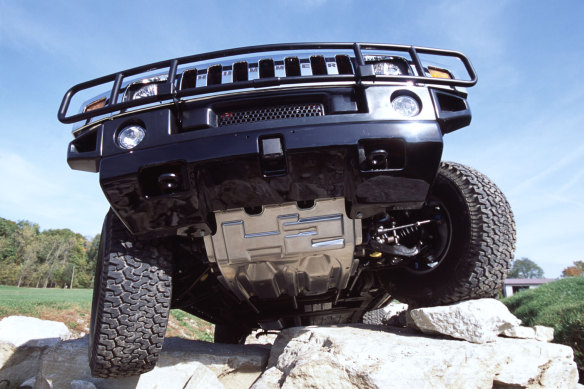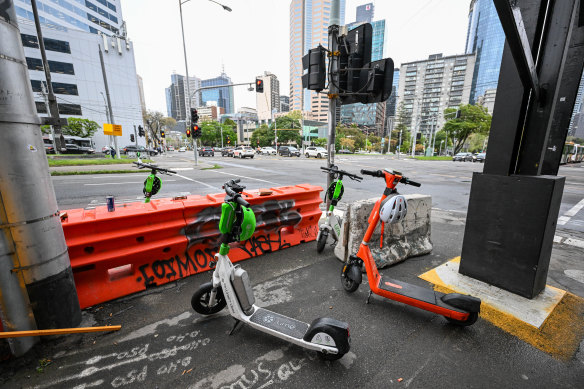Opinion
Sure, ban scooters. While you’re at it, ban monster SUVs as well
Denis Moriarty
Social entrepreneurThe City of Melbourne’s trial of rental electric scooters ended this week, on the grounds that they posed “unacceptable safety risks”. People tended to ride them illegally on footpaths, hassle older people, and not wear their helmets, leading to accidents – 256 cases at the Royal Melbourne Hospital’s emergency admissions in 2022.
Even more seriously, police have apparently reported seven deaths among riders since 2021 – about two a year. But it’s not just the riders getting into serious scrapes – nine crashes involved pedestrians in 2022, most serious enough for them to be admitted to hospital.

The modern four-wheel drive is in your face and built, it seems, for the end of days.Credit: Hummer
You can see why people might object to scootering, certainly, on these figures. What’s less clear is why we don’t use the same principles to assess our relations with cars. Even without taking over the pavement, cars do hit people rather a lot. Those two deaths on scooters can be compared with 36 pedestrian deaths in Victoria so far this year – a figure that has sharply increased but which we seem to accept with a stoic indifference. Drivers and passengers are also dying at higher rates, and we still just shrug. After a long decline, road death numbers are now trending up (an increase of about 5 per cent per head in 2023).
While terminating our 100-year trial of the private car would be a major step towards transport safety, I concede that it’s an unrealistic proposal. But there are valuable intermediate steps that we could take. We could, for example, drive smaller cars, and encourage other people to do that, instead of taking pride in moving the size gauge towards “tank”. Over the past decade or so SUV and light commercials have soared from 45 per cent of new vehicle sales to over 75 per cent. You can’t tell me they’re all tradies carrying sacks of plaster or rural folk wanting a platform for their kelpie.
These heavier cars are considerably more lethal. Research out of America shows that bigger cars are more likely to kill pedestrians (partly because of poor visibility and more blind spots). They’re also a danger to drivers in smaller cars – in a collision, more weight means more damage.
Even larger-mass monsters will soon roll down our streets. GMC’s EV Hummer is set to go on sale here by the end of the year, tipping the scales at 4.5 tonnes. That’s triple the mass of an average sedan. Having those on the prowl is sure to make school drop-offs a nerve-wracking affair.
Specifically, a recent report in The Economist found that “for every 10,000 crashes, the heaviest vehicles kill 37 people in the other car, compared with … just 2.6 for the lightest”.

It’s all over for shared e-scooters in the City of Melbourne.Credit: Joe Armao
That’s a feature, not a bug. If there’s going to be a collision, drivers are perfectly aware they will come out of it best, sweeping the Mini or Kia away like a discarded coffee cup. These collisions won’t happen often, and fortunately airbags and crumple zones will help save the lives of most involved in vehicle accidents. But it’s time we properly considered the costs associated with the image of masculine strength that goes with our glorification of the tradie, the sparkie, the chippie and the small operator generally – the image that (coupled, to be sure, with some fairly stupid tax incentives) drives so many of us to buy Toorak tractors.
Large cars have implications for public spaces; they effectively make roads narrower and parking spaces smaller, passing the problems along to the community generally. In response, overseas municipalities such as London, Paris, Washington DC, and the Germany city of Tuebingen are pushing for anti-congestion schemes that charge more for vehicles that use more space.
In Australia, we still see the ability of the single driver to puff up like a toad to 200 times their naked size as a constitutionally guaranteed freedom, forcing Standards Australia to consider making parking spots even larger. Private parking is important to us in a way that the 400-odd tonnes of carbon dioxide the City of Melbourne avoided through the use of scooters is not.
Larger cars are also, of course, a good deal worse for our emissions, using more steel and consuming more petrol, bringing forward the times of tribulation where crops fail, populations move, and people die of heatstroke by the thousands, making all these calculations about the risk of scooter use pretty meaningless.
The internal combustion engine isn’t dead just yet – to avoid any appearance of tyrannising over it, the government response to the continuing expansion of vehicles and corresponding
reductions in usable road space and pedestrian survival rates has been to introduce fuel
efficiency standards, a corrective measure that is imposed on the manufacturer rather than the driver.
Whatever people say, the evidence repeatedly indicates that we are prepared to make only the most featherweight of sacrifices to avoid a problem more than one election away.
Cost-of-living crisis be damned. Australia is feeling the consequences of pervasive gigantism, demanding larger cars and larger homes and larger billionaires. If we were prepared to shrink our footprint, to share our space, to pay the proper price for the increasing share of the public commons we each pocket, there would be more than enough for everybody. Sure, we’ll need policies to achieve this. It’s clear we’ll soon have to reconsider our systems for taxing transport as electric cars drive down fuel tax takings, so there’s an opening for new ideas. But first, there’s the issue of public attitudes.
Australian voters say they want to fight global warming and value human lives. Australian consumers, however, demand more and bigger. Effectively, Australians demand that their private actions not have public consequences. Governments despairingly agree. The planet, however, is less persuadable.
Denis Moriarty is group managing director of OurCommunity.com.au, a social enterprise that helps the country’s 600,000 not-for-profits.
The Opinion newsletter is a weekly wrap of views that will challenge, champion and inform your own. Sign up here.